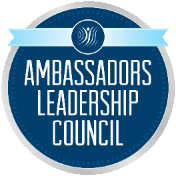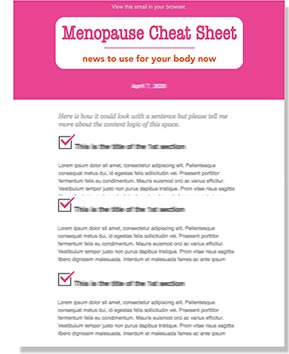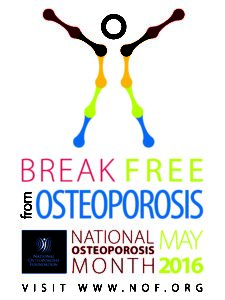
The next time you reach for that fourth cup of coffee (or worse, a donut) when energy starts to lag and posture starts to sag, consider this: maybe you’re losing steam because you’re losing muscle.
A new survey conducted by AARP and Abbott (makers of nutritional drinks Ensure and Enlive) supports the well-known adage: “a body in motion, stays in motion.” It’s true: the more we move our bodies, the more energy and stamina we have.
When we feel tired, fingers usually point to a bad night’s sleep. But, the real culprit could be muscles that are getting weak because they’re losing mass. The National Institute on Aging reports that as we start to lose essential muscle mass after the age of 40, it can cause strength, balance, and flexibility to decline. What’s more, energy and stamina take a nosedive, too, having a direct impact on our daily lives.
Weak muscles can stop us from enjoying many things we love to do that involve physical activity — walking, gardening, picking up children, playing tennis or golf — but can also make simple things like carrying heavy groceries a real challenge.
(Note: I recently attended an event hosted by AARP and Abbott when they introduced the new survey to the media, at which they had a few weights that could be strapped on to arms, legs and torso so you could actually feel what’s it’s like to lose muscle mass. Here’s a photo of me looking chipper, but I sure wasn’t after I tried to walk around, get up after sitting, and lift a heavy bundle. No question that weak muscles make eve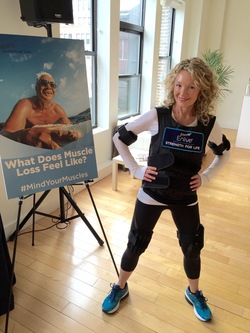
We need strong muscles to support our bones.
Loss of muscle mass has a medical name: sarcopenia. And, while sarcopenia may interfere with your ability to play a competitive game of tennis, there’s an even bigger reason why you need to mind your muscles:
Adults with sarcopenia, or low muscle mass, are two times more likely to have osteoporosis compared with those who do not, and osteoporosis can lead to fractures.
Dr. Andrea J. Singer, Clinical Director of the National Osteoporosis Foundation and women’s health expert at MedStar Georgetown University Hospital, explains it this way:
In order to better identify those who will fracture, we need to think “beyond the bone.” This includes focusing on sarcopenia, which is defined as “the age-related gradual loss of muscle mass, strength and function.” Sarcopenia, which can also occur due to illness, increases the risk for falling and many osteoporosis-related fractures are due to falls. In other words, bone breaks occur due to loss of bone mass/strength AND loss of muscle mass/strength as we age. As a result, we fall down on weak bones and they break.
Good news: you can stop bone loss and rebuild muscle mass.
While it’s possible to slow down — even stop — bone loss, it’s hard to completely reverse it. However, muscle loss is reversible! If you’ve experienced age- or illness-related muscle loss, you can turn things around with exercise and proper nutrition. Bonus: strengthening your muscles will boost energy level and help protect your bones.
Put your health in your own hands.
The really great news is that what’s good for your bones is good for your muscles, too! Except to really get muscles back to where they should be, you need to pay special attention to the amount of protein you’re consuming every day. Here are the best recommendations for strengthening bones and muscles:
- Move your muscles. Many participants in the survey exercise regularly, but most focus on activities that give them a cardio workout, with very little attention paid to their muscles and bones. One of the articles I wrote in this series about preventing osteoporosis focused on the 5 best exercises to keep bones strong, including running, jumping jacks and push-ups. Guess what? Those are the exact same ones you should be doing to build back muscle mass, too. Check out the full list here.
- Eat more protein. Almost 62 percent of the adults surveyed believe they get enough protein, but only 17 percent knew the actual amount that they should get, or were actually getting. The
recommended daily amount is 53 grams for a 150 pound adult and 63 grams for someone who weighs 180 pounds; however, research shows that adults over 70 need nearly twice this amount to help preserve their muscles. A few good sources of healthy protein to build muscle mass are lean meats, yogurt, cottage cheese, almonds, broccoli, eggs, and nutritional drinks with added protein, like Enlive, the new shake from the makers of Ensure. A lot of those foods also happen to be great sources of calcium, too, which is essential for keeping bones strong.
Knowledge is power and this is especially true when it comes to your health.
Stay informed and take control wherever you can. For more information on how to keep your bones and muscles strong for life visit www.nof.org.


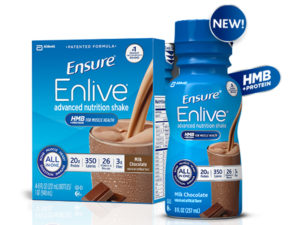 recommended daily amount is 53 grams for a 150 pound adult and 63 grams for someone who weighs 180 pounds; however, research shows that adults over 70 need nearly twice this amount to help preserve their muscles. A few good sources of healthy protein to build muscle mass are lean meats, yogurt, cottage cheese, almonds, broccoli, eggs, and nutritional drinks with added protein, like
recommended daily amount is 53 grams for a 150 pound adult and 63 grams for someone who weighs 180 pounds; however, research shows that adults over 70 need nearly twice this amount to help preserve their muscles. A few good sources of healthy protein to build muscle mass are lean meats, yogurt, cottage cheese, almonds, broccoli, eggs, and nutritional drinks with added protein, like 

























































